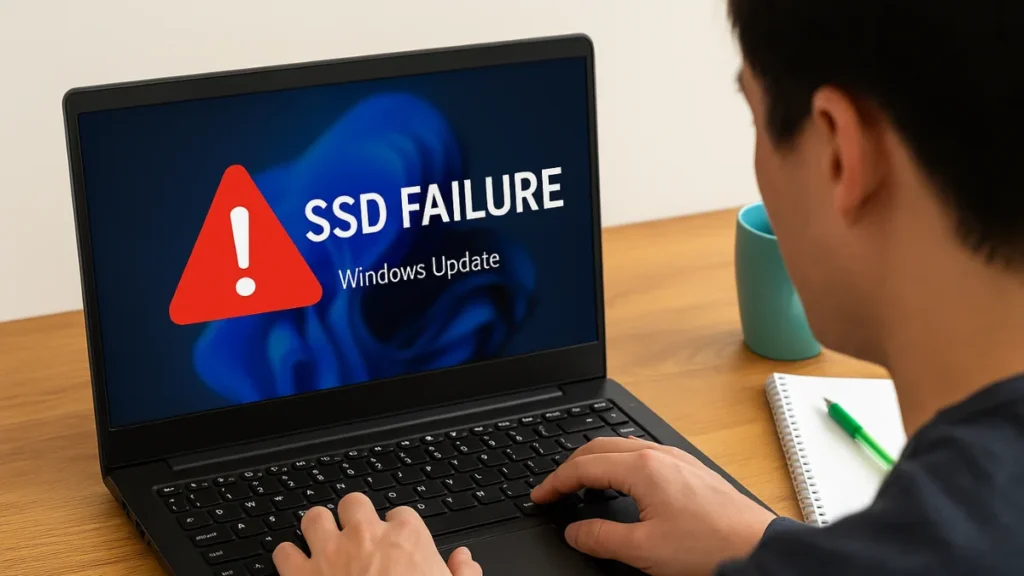Last updated on September 10th, 2025 at 11:13 am
Microsoft’s latest Windows 11 security update KB5063878 (August 12, 2025) is under fire after multiple reports surfaced of solid-state drives (SSDs) disappearing—or even becoming permanently unusable—under certain conditions. While not everyone is affected, the risk of data loss is significant enough to warrant caution.

What’s the Problem With the Latest Windows Update?
The update appears to trigger failures when large continuous writes (50GB or more) are performed on SSDs that are over 60% full. In these scenarios, drives may:
- Disappear from Windows 11 (and sometimes BIOS)
- Show up as RAW partitions
- Become temporarily inaccessible but return after a reboot
- In rare cases, become permanently unrecoverable
While the bug has mainly been observed with SSDs, there are also reports of HDDs being affected.
Windows Update SSD Stress Test Findings
X user @Necoru_cat (Nekorusukii) ran stress tests across 21 SSD models from Samsung, WD, Corsair, SK hynix, Crucial, ADATA, Seagate, and others. The test involved writing and decompressing a 62GB archive repeatedly after reboots.
- NG Lv.1 (Temporary failure): Drive disappeared, but reboot restored functionality.
- NG Lv.2 (Permanent failure): Drive data unrecoverable, even after reboot.
The most severe case was a WD Blue SA510 2TB SATA SSD, which became permanently unusable. Several other drives failed under stress but returned after a restart.
Which SSDs Are Impacted by the KB5063878 Update?
The issue is not limited to one brand. Early reports and testing suggest higher risk for drives using certain Phison NAND controllers, though failures were also observed across other manufacturers. Affected drives include:
- Corsair Force MP600
- SSDs with Phison PS5012-E12 controllers
- KIOXIA EXCERIA PLUS G4 / KIOXIA M.2 SSDs
- SanDisk Extreme Pro 3D
- InnoGrit and Maxio SSDs
By contrast, Silicon Motion confirmed that its SSD controllers are not affected by the bug.
Recovery Tools Broken in a Separate Windows Update Bug
To make matters worse, a separate August update (KB5063875) caused “Reset this PC” and recovery operations to fail on Windows 10 and some Windows 11 versions. Microsoft has since released an out-of-band emergency patch (KB5066189/KB5066188) to fix this.
While unrelated to the SSD failures, it highlights why caution is needed with recent updates.
Fixes and Workarounds for SSD Failure After Windows Update KB5063878
While Microsoft has not released a dedicated patch for SSD failures, multiple investigations now indicate the update itself is not the root cause. Still, here are safe steps you can take if you encounter problems:
1. Roll Back the Update
If issues began after KB5063878:
- Open Settings > Windows Update > Update History
- Select Uninstall Updates
- Remove KB5063878
This will return your PC to the previous stable state.
2. Pause Windows Updates
To avoid the buggy update reinstalling automatically:
- Open Settings > Windows Update
- Choose Pause Updates for up to 5 weeks
This prevents interruptions while Microsoft continues monitoring.
3. Limit Heavy SSD Operations
Until everything stabilizes, avoid:
- Copying or transferring files larger than 50GB
- Installing massive games/apps
- Filling your SSD beyond 60%
4. Back Up Your Data Immediately
Follow the 3-2-1 backup rule (3 copies, 2 media types, 1 off-site).
5. Recovery Options if SSD Disappears
If your SSD shows as RAW or vanishes:
- Restart your PC (may restore it temporarily)
- Use tools like TestDisk to rebuild partition tables
- For severe failures (e.g., WD Blue SA510), seek professional recovery services
6. Updated Investigation Findings
- Microsoft and Phison both confirmed after extensive testing (4,500+ hours) that KB5063878 is not bricking SSDs.
- The failures appear linked to engineering/test firmware, not consumer firmware.
- This means most retail users are safe, but keeping firmware updated is strongly recommended.
Should You Worry About This Windows 11 SSD Bug?
Not every system or drive is impacted—many users with the same update report no issues. Still, because failures occur under specific workloads, the safest approach is to limit heavy writes and keep backups.
For casual users, the risk is low during normal daily tasks. For gamers and professionals dealing with large installs or video editing workloads, the risk is higher.
Related Guides You Might Like:
- Windows 10 Won’t Boot on My PC – 12 Proven Fixes to Start Your Computer Again
- DISM Error 87 Fix in Windows 10/11: Causes, Solutions, and Step-by-Step Guide
- Quick Fix: ESENT 642 wuaung.dll Error in Windows 10/11 (Complete Guide)
- How to Enable MSI Click BIOS 5 Secure Boot for Windows 11 & PC Security
- How to Install Windows 10 on GPT Partition Without Errors

